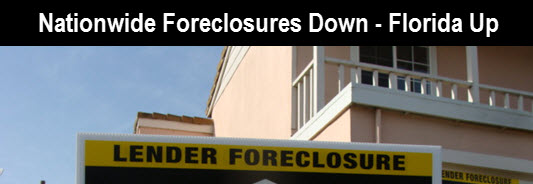Foreclosures Down Nationwide, But Not In Florida
Posted June 19, 2019 08:30 am

TALLAHASSEE – Foreclosures are down nationwide since last spring but not in Florida, where foreclosure filings increased by 23 percent this May compared to May 2018, according to ATTOM Data Solutions' May 2019 U.S. Foreclosure Market Report (FMR).
June began with one of every 1,238 Florida homes in foreclosure, the nation’s third-highest rate, behind only New Jersey’s (one in every 1,117) and Maryland’s (one in every 1,127}, ATTOM Data Solutions reported last week.
According to ATTOM’s RealtyTrac.com, in mid-June there were 94,062 properties in Florida listed in some stage of foreclosure, default, auction or as bank owned, including more than 3,800 procedures started in May. In 2018, there were 33,031 foreclosure starts statewide, the report documents.
Despite the high foreclosure rates, Florida’s overall real estate market continues to stabilize from the recession that followed the 2007 housing market crash, presaged in 2006 when the foreclosure process was initiated on one in every 102,875 homes in the state.
Nationally, the foreclosure process was started on 30,554 U.S. properties in May 2019, less than 1 percent more than in April but down 9 percent from May 2018. the fourth consecutive month with an annual decline, according to May’s FMR posted on ATTOM’s RealtyTrac.com.
In May 2019, the foreclosure process was completed on 10,634 U.S. properties, down 4 percent from April and down 50 percent from May 2018, seventh consecutive annual decline, the report documents.
"We are continuing to see a downward trend with overall foreclosure activity, especially in completed foreclosures declining year after year," ATTOM Data Solutions Chief Product Officer Todd Teta said in a study synopsis. "However, in May 2019 we did see an uptick in the number of states increasing in foreclosure starts going from 17 to 23 states rising annually – and again Florida is bucking the national trend with a continuous annual increase."
Florida’s rate of one in every 1,238 homes somehow embroiled in the foreclosure process is significantly higher than the national rate of one in every 2,411.
The five counties with the highest foreclosure rates are in rural central or north Florida: Hendry one in every 458; Clay one in every 580; Gilchrist one in every 620; Lafayette one in every 645; and Desoto one in every 652.
According to ATTOM’s FMR, Jacksonville had the second-highest foreclosure rate among metro areas nationwide with more than 200,000 residents – one in every 764 homes was at some stage in the foreclosure process last month.
In May, the number of properties that received a foreclosure filing in Florida was 14 percent higher than the previous month and 8 percent higher than the same time last year, marking the 12th month in a row Florida had seen double-digit annual increases in foreclosure starts.
Data released in early June by the U.S. Department of Housing and Urban Development (HUD) about an alarming spikes in seniors losing their homes in foreclosure under reverse mortgage contracts could be a contributor to Florida’s relatively high foreclosure rates.
Reverse mortgages, or home-equity conversion mortgages, are available to homeowners over age 62 who want to cash in their homes’ equity. As long as they live in the home, they make no payments on the “borrowed” money, which isn’t paid back until the property is sold after the homeowner dies or moves.
Since 1990, according to the National Reverse Mortgage Association (NRMA), borrowers have taken out 1.3 million reverse mortgages across the country.
About half – 650,000 – are outstanding with 13 percent, or nearly 85,000, held by Floridians, the second-most in the nation, NRMA states.
In early June, HUD identified nearly 15,000 out of the 85,000 Floridans with reverse mortgages as being “in danger of losing their homes in the coming years.”
These “at-risk” reverse mortgage holders tend to be elderly, isolated and failing to pay taxes, fees and utilities, allowing their homes to go into foreclosure proceedings.
Eight of the 25 ZIP codes with the most reverse-mortgage related foreclosures “are in Florida, more than in any other state,” HUD reports. “Those eight ZIP codes have more foreclosures than many entire states combined.”
According to an analysis by USA TODAY in partnership with Grand Valley State University, with support from the McGraw Fellowship for Business Journalism, 16,654 reverse mortgage holders in Florida went into foreclosure between 2012-17, the most in the nation and nearly double second-highest California,
The sustained pattern indicates more than 330 Floridians with reverse-mortgages lose their homes in foreclosure a year – significant if you are a reverse mortgage holder, but not a big enough number to affect the state’s overall foreclosure rate.
-------------------------------
This piece appeared in the The Center Square and was reprinted by the Columbia County Observer with permission or license.
Layout and graphic added by the Observer; composite image by the Observer. Original image by Brendel, (CC BY-SA 3.0)

 By
John Haughey | The Center Square
By
John Haughey | The Center Square